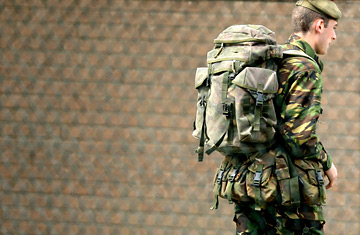
A British soldier arrives back at Palace Barracks, Belfast, Northern Ireland, Tuesday, July 31, 2007.
Occasionally city traffic in central Belfast will still part for armored military Land Rovers. But when the roof hatch pops open, no soldiers peer out for snipers or car bombs; the occupants are usually whooping stag parties scouting for the next bar or tuxedoed kids on their way to the Irish equivalent of the prom.
Such novelty limos, bought up as military surplus, are the most visible trace remaining of the British Army on the streets of Northern Ireland's capital. The troops themselves have mostly gone, and on July 31, Operation Banner, an emergency deployment that lasted 38 years and brought more than 300,000 troops to Northern Ireland, officially ended. The quiet close to the campaign draws a curtain on the region's years of conflict.
Operation Banner began in August 1969, the same weekend that hippies were gathering in upstate New York for the Woodstock Festival. After street violence overwhelmed local police, troops wearing World War II-issue steel helmets were sent in to separate rioting factions of Protestants and Catholics. They may not have expected to be home by Christmas, but no one imagined the deployment would become the longest single operation ever undertaken by the British Army. By the time the majority of troops departed, now with Kevlar on their heads, many were bound for Afghanistan or Iraq; most British soldiers today hadn't been born when the operation began.
The peacekeeping role of 1969 quickly deteriorated. Relations with the disgruntled Catholic minority turned sour, irreparably, after paratroopers killed 14 people in a 1972 shooting still remembered as Bloody Sunday. Soldiers were soon fighting urban gun battles with the Irish Republican Army. In 1972, the worst year of the conflict, 134 soldiers were killed, almost as many as have died in the past four years in Iraq.
The conflict simmered down over the next two decades, but couldn't quite cool. The IRA seemed perpetually convinced that attrition would drive the British out, while the British believed an aggressive, covert campaign of ambushes would paralyze the IRA.
Neither view was right; it was only when both sides gradually realized that they had reached a military stalemate that space opened in the '90s for a political settlement. By then, during what the Army calls the "long tail" of the deployment, Operation Banner had turned into a kind of weird normality for the citizens of Northern Ireland: it was not uncommon to see patrolling soldiers, kitted out in body armor and carrying enough firepower to stop traffic, patiently waiting for the walk light at a pedestrian crossing.
Prolonged fine tuning of the political deal — it was really only completed earlier this year — allowed for a gradual reduction of the British Army's role. The remaining garrison of several thousand soldiers is scarcely bigger than it was before the outbreak of violence in 1969. Watchtowers and fortified bases have been closed and patrolling dwindled, then stopped. The last military fatality was more than a decade ago.
In that sense, the formal end of Operation Banner was simply a recognition of reality. Its legacy may be harder to make out. Certainly Northern Ireland was a defining theater for the British Army — most of its current generals started out as platoon leaders in Belfast — and the birthplace of many counter-insurgency techniques currently being used in Iraq.
Gerry Kelly, a onetime IRA leader who is now a minister in the Northern Ireland government, says such tactics are misplaced; he believes they only prolonged the conflict in Northern Ireland. The Army's own conclusion is that they kept the IRA at bay so a settlement could be reached. That is another battle that won't be settled easily. But at least it's a fight for historians, not for soldiers.
